
Ferrari F40 (1988-1992)
The Ferrari F40 was the last car introduced and commissioned by Enzo Ferrari himself. Its introduction and its name coincided with Ferrari’s 40th anniversary as an automobile constructor. The car was a celebration of the marque and the man seeking to safely provide owners with a race car for the street, embodying all the finest elements of 1987 automotive engineering.
On July 24 1987 – Enzo Ferrari – In a ceremony commemorating his company’s fortieth year, unveiled the Ferrari F40 at the factory in Maranello, Italy. Speaking through an interpreter during the ceremony, the eighty-nine-year-old Ferrari announced, “A little more than a year ago, I expressed my wish to the engineers. Build a car to be the best in the world. And now the car is here.” Ferrari’s engineers had designed the F40 to be the fastest road vehicle ever built. They viewed the Porsche 959 as their major competition, but while the Porsche was equipped with luxury amenities, the F40 was to be all nuts and bolts. Every spoiler on the F40 played a vital role in keeping the car on the ground at speed; every vent was essential to keep the brakes and engine cool.
The F40 was to a large extent an evolution of the GTO in both form and concept. Though not designed for a particular racing series, it was a car that could be driven to a track and raced competitively at a professional level. It was a leap forward from the GTO in aerodynamic, structural, and performance terms. As befitted a car designed with such dynamic purpose, it had a somewhat spartan interior: the focus was unification of man and machine, combining for awesome acceleration, handling, speed, and presence.
The F40 came with no floor mats, no stereo, no power locks or windows. Its only frill was a vanity window displaying its massive V-8 engine but this too was a part of the remarkably light composite body, molded of plastic, ceramic, and metal. The result of Ferrari’s vision was the ultimate road vehicle for the ambitious driver. While the car had no electronic braking system, it was capable of 0-60 miles per hour in 3.5 seconds and could hold a top speed of 201 miles per hour, making the F40 the first production sports car to top the 200 mile per hour barrier. Like all of Ferrari’s great cars, the F40 has enjoyed a successful career in sports car racing around the world.
The F40 continued the extreme machine philosophy cultivated by its predecessor the GTO, but took it to new levels. During the mid eighties there were various spy pictures in motoring magazines of a radical prototype(s) around the streets of Maranello, with all sorts of hypothesis as to its raison d’etre. It subsequently transpired that the car was what became known as the “Evoluzione”, a test bed for the upcoming F40. A total of five “Evoluzione” models were built for evaluation purposes, four of which were eventually sold to private clients, and the fifth retained by the factory. When the F40 was eventually announced in the middle of 1987 its Pininfarina designed body took everybody’s breath away, it was raw and mean, a car that looked like a racing model, but that was totally road legal and could be driven to the shops if desired. The F40 model title was derived from “F” for Ferrari and 40 represented the fortieth anniversary of Ferrari car production. It was also the last new car presentation attended by Enzo Ferrari before his death in August 1988.
The only trace elements of the 308 ancestry remained around the cabin profile and satin black painted side indent line, otherwise the radical body styling was all new, as were its construction materials. The low mean and wide front end flowed via an eclectic array of cooling slots and intake ducts through to the tail, with its panoramic rear screen under which lay the engine, and behind which projected the high mounted integral full width wing, that presented the ultimate eighties power statement. The public loved it, and queues of clients formed cheque book in hand, to join the waiting list, despite Ferrari refusing to say exactly how many would be built and over what period. This was to try and negate a repeat of the extraordinary clamour for the GTO, and thus left production open ended, but it did nothing to calm the storm. It was just so radical, so fast and so covetable, that people wanted it, and they wanted it now! At the height of the supercar boom in 1989 they were changing hands at around a million pounds! Production continued through to 1992, during which time 1311 examples were produced in the chassis number range 76624 to 95317, nearly five times as many as the GTO. Racing versions with the suffixes LM and GT-E were developed by Michelotto of Padova, and enjoyed success over a number of years during the nineties in European GT racing with various private entrants.
The bodies were mounted on a 2450mm wheelbase chassis, as on the GTO, but both front and rear track were increased, as was the overall length mainly due to the longer more aerodynamic nose. The chassis had factory reference numbers F 120 AB, all were numbered in the continuous chassis number road car sequence, which commenced from chassis number 75000. The construction followed the Ferrari principle of a tubular steel chassis frame, now with a progressively deformable front section to meet increasing legislation worldwide. The overall premise was similar to that of the GTO, however there were additional stiffening braces, and the composite elements were bonded to the chassis frame with a special adhesive to provide even greater strength. The F40 was the first series production car to use mainly composite materials for its body panels, which totalled only eleven pieces, due to the large single unit front and rear sections. Whereas the GTO chassis had a bolted rear section to simplify engine removal, this element was unnecessary on the F40 due to the fully removable rear body section, which provided good access to all the mechanical components. The road wheels were five spoke Speedline manufactured split rim units attached by a single nut to a Rudge hub, 8J x 17″ diameter at the front, and 10J x 17″ diameter at the rear. These covered large cross drilled ventilated disc brakes with twin hydraulic circuits, without servo assistance. Independent suspension via tubular steel wishbones, coil springs, and hydraulic shock absorbers was provided, together with front and rear anti roll bars. A height adjustable electronically controlled suspension system became available as an option during the production period.
The mid mounted engine was a 90 degree V8 unit fitted longitudinally as in the GTO. However the development work on the “Evoluzione” models in the interim saw a small increase in capacity, a slightly higher compression ratio of 7.7:1, a rise in boost pressure, and numerous other changes that resulted in a significant increase in power output and also improved torque. The total cubic capacity was 2936cc, with an 81.9mm x 69.5mm bore and stroke, and factory type reference F 120 A. When catalytic convertors were fitted the engine type number became F 120 D 040. It had four valves per cylinder, twin overhead camshafts per bank, each bank being provided with its own toothed drive belt, dry sump lubrication, with twin IHI water cooled turbochargers feeding intake air via a pair of Behr intercoolers at 1.1 bar, coupled to a Weber-Marelli IAW combined ignition/fuel injection system, to provide a claimed power output of 478bhp at 7000rpm. The differential assembly was mounted on the back of the engine in unit with the rear mounted five speed all synchromesh gearbox. A non synchromesh “sports” gearbox was available as option, for those who wanted to take the racing concept to the extreme.
As with the GTO, you could have any colour you liked, as long as you liked red! Similarly if you wanted one then it had to be left hand drive, although this time a USA market version was made available. This can be identified externally by a deep black rubber chin spoiler, front side marker lights in the body side indent line, which also has a black rubber insert in the tail section, with a rear side marker light above the indent line on the rear wings. One concession was made to creature comfort, as air conditioning was fitted as standard. Otherwise the interior was spartan in the extreme, with a pair of red cloth covered sports seats, and apart from the roof lining, the felt covered dashboard and central tunnel, plus a driver’s rubber heel mat, there was no interior trim, only plain or painted composite material surfaces. No electric windows, just a simple manual winder on the inner door panel, or sliding panels in plastic windows on early series cars, whilst the door release catch was a pull wire in the bare door pockets. The driver was provided with a satin black finished, three spoke, leather rimmed steering wheel, and drilled aluminium foot pedals. This minimalist interior accentuated the racer for the road appeal, and completed the image of a serious piece of equipment.

Specifications and Features
|
Production |
|
|
1987–1992 |
1,311 produced |
|
Dimensions |
|
|
Length |
173.2 in / 4358 mm |
|
Width |
77.6 in / 1970 mm |
|
Height |
44.3 in / 1124 mm |
|
Wheelbase |
96.5 in / 2450 mm |
|
Front track |
62.8 in / 1594 mm |
|
Rear track |
63.2 in / 1606 mm |
|
Weight (Dry) |
2976 lbs / 1100 kg |
|
Front Brakes |
13.1″ Ventilated discs, four piston calipers |
|
Wheels front |
8 x 17 |
|
Wheels rear |
10 x 17 |
|
Tires front |
245/40 ZR 17 or 235/45 ZR 17 |
|
Tires rear |
335/35 ZR 17 |
|
Engine |
|
|
90° alloy Twin Turbocharged V8 mounted longitudinally rear amidship |
|
|
Dual Overhead Camshafts, Four valves per cylinder |
|
|
Displacement |
2936cc (Unitary displacement. 367.03 cc) |
|
Bore & Stroke |
81.9mm x 69.5mm |
|
Compression |
7.7:1 |
|
Turbochargers |
IHI |
|
Intercoolers |
Behr |
|
Maximum Power |
(351.5 kW) 478bhp @ 7000 rpm (Power per litre.163 hp/l) |
|
Maximum Torque |
424lb-ft @ 4500 rpm |
|
Specific Output |
163 bhp / liter |
|
Valve actuation |
twin overhead camshafts per bank, four valves per cylinder |
|
Fuel System |
Weber-Marelli |
|
Fuel feed |
Weber-Marelli electronic injection, twin turbos |
|
Ignition |
Weber-Marelli electronic, single spark plug per cylinder |
|
Lubrication |
dry sump |
|
Clutch |
twin-plate |
|
Bodywork / Chassis |
|
|
Type |
two-seater berlinetta |
|
Transmission |
5-speed + reverse |
|
Steering |
rack-and-pinion |
|
Fuel tank |
capacity 120 litres |
|
Frame |
tubular steel and composites |
|
Front suspension |
independent, unequal-length wishbones, coil springs over telescopic shock absorbers, anti-roll bar |
|
Rear suspension |
independent, unequal-length wishbones, coil springs over telescopic shock absorbers, anti-roll bar |
|
Performance |
|
|
0-60mph |
4.5 s. |
|
Top Speed |
201 mph |
|
1/4 mile |
11.7s @ 127mph |
Gallery


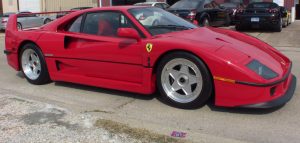
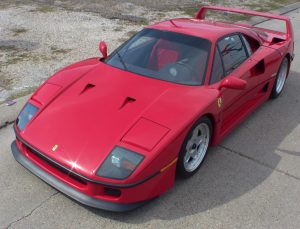
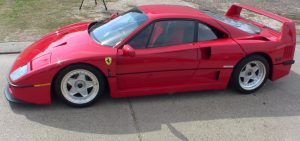
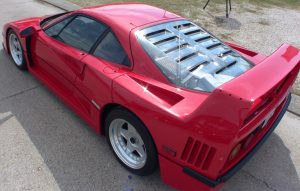
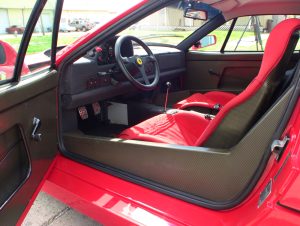


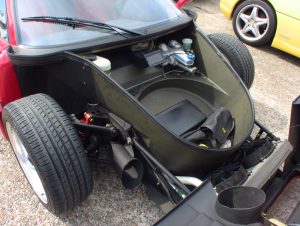



You must be logged in to post a comment.